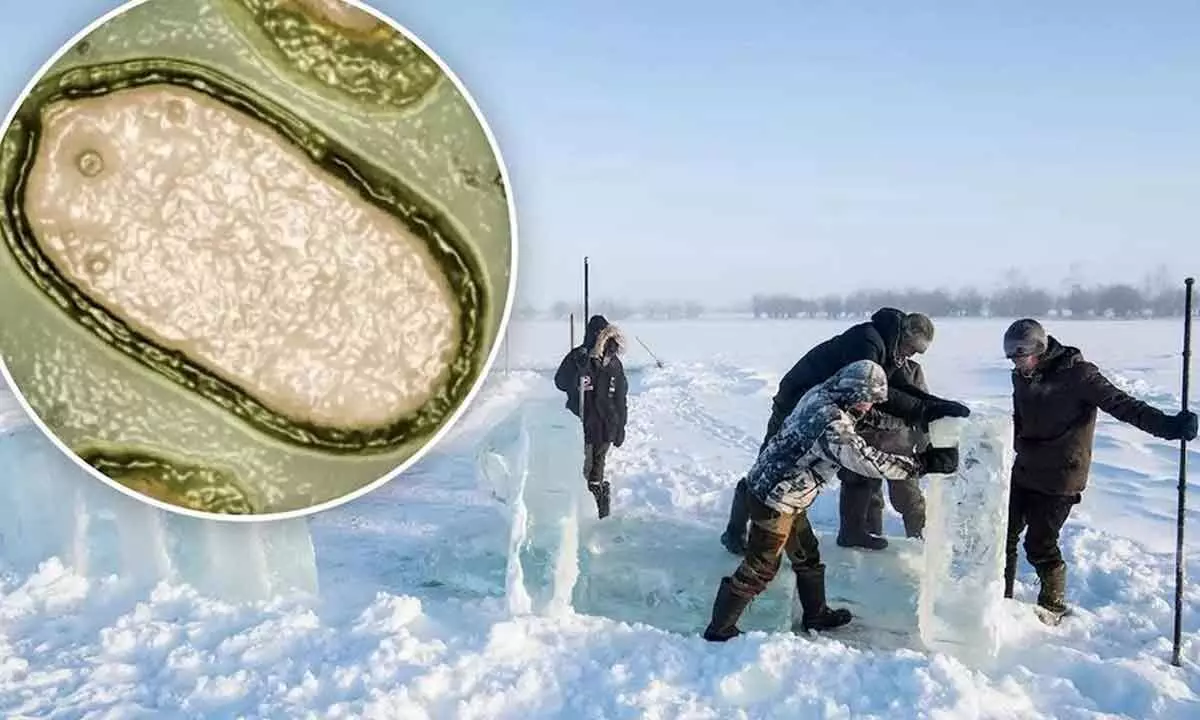Live
- Maruti Suzuki inaugurates 500th NEXA Service touchpoint
- Royaloak Furniture Announces Exciting Year-End Sale providing up to 70% off on all International Furniture & décor products
- Pakistani Girl Murdered in UK: Father and Stepmother Convicted in Sara Sharif Case
- Maha Kumbh Mela: Understanding Its Unique Significance
- YouTube Introduces Real-Time Multiplayer Gaming with Playables
- AUS W vs IND W 3rd ODI: Smriti Mandhana Makes History with Stunning Century in Perth
- CM Revanth Reddy Congratulates Telangana Candidates Advancing to UPSC Interviews
- Collector Inspires Students to Excel Through Discipline, Hard Work, and Smart Work
- District Collector Directs Officials to Expedite Paddy Procurement Process
- SP T. Srinivas Rao Inaugurates State-of-the-Art Volleyball Court for Police Personnel in Jogulamba Gadwal
Just In
Pandoravirus: Melting Arctic unleashing ancient germs


Scientists have recently revived several large viruses that had been buried in the frozen Siberian ground (permafrost) for tens of thousands of years. The youngest virus to be revived was a sprightly 27,000 years old.
Norwich: Scientists have recently revived several large viruses that had been buried in the frozen Siberian ground (permafrost) for tens of thousands of years. The youngest virus to be revived was a sprightly 27,000 years old. And the oldest – a Pandoravirus – was around 48,500 years old. This is the oldest virus ever to have been revived.
As the world continues to warm, the thawing permafrost is releasing organic matter that has been frozen for millennia, including bacteria and viruses – some that can still reproduce. This latest work was by a group of scientists from France, Germany and Russia; they managed to reanimate 13 viruses – with such exotic names as Pandoravirus and Pacmanvirus – drawn from seven samples of Siberian permafrost.
Assuming that the samples were not contaminated during extraction (always difficult to guarantee) these would indeed represent viable viruses that had previously only replicated tens of thousands of years ago.
This is not the first time that a viable virus has been detected in permafrost samples. Earlier studies have reported the detection of a Pithovirus and a Mollivirus.
In their preprint (a study that is yet to be reviewed by other scientists), the authors state that it is "legitimate to ponder the risk of ancient viral particles remaining infectious and getting back into circulation by the thawing of ancient permafrost layers".
So what do we know so far about the risk of these so-called "zombie viruses"? All the viruses cultured so far from such samples are giant DNA viruses that only affect amoebae. They are far from viruses that affect mammals, let alone, humans and would be very unlikely to pose a danger to humans.
However, one such large amoebae-infecting virus, called Acanthamoeba polyphaga mimivirus, has been linked to pneumonia in humans. But this association is still far from proven. So it does not appear that the viruses cultured from permafrost samples pose a threat to public health.
A more relevant area of concern is that as the permafrost thaws it could release the bodies of long-dead people who might have died of an infectious disease and so release that infection back into the world. The only human infection that has been eradicated globally is smallpox and the reintroduction of smallpox, especially in hard-to-reach locations, could be a global disaster. Evidence of smallpox infection has been detected in bodies from permafrost burials but "only partial gene sequences" so broken bits of virus that could not infect anyone. The smallpox virus does, however, survive well when frozen at -20°C, but still only for a few decades and not centuries.
In the last couple of decades, scientists have exhumed the bodies of people who died from the Spanish flu and were buried in permafrost-affected ground in Alaska and Svalbard, Norway.
The influenza virus was able to be sequenced but not cultured from the tissues of these deceased people. Influenza viruses can survive frozen for at least a year when frozen but probably not several decades.
Bacteria could be more of a problem: Other types of pathogen, such as bacteria, could be a problem, though. Over the years, there have been several outbreaks of anthrax (a bacterial disease that affects livestock and humans) affecting reindeer in Siberia. There was a particularly large outbreak in 2016 that led to the deaths of 2,350 reindeer. This outbreak coincided with a particularly warm summer, which led to the suggestion that anthrax released from thawing permafrost may have triggered the outbreak.
Identified outbreaks of anthrax affecting reindeer in Siberia date back to 1848. In these outbreaks, humans were also often affected from eating the dead reindeer. But others have highlighted alternative theories for these outbreaks that do not necessarily rely on thawing permafrost, such as stopping anthrax vaccination and overpopulation by reindeer. Even if permafrost thawing was triggering anthrax outbreaks that had serious effects on the local population, anthrax infection of herbivores is widespread globally, and such local outbreaks are unlikely to trigger a pandemic.
Another concern is whether antimicrobial-resistant organisms could be released into the environment from thawing permafrost. There is good evidence from multiple studies that antimicrobial resistance genes can be detected in samples of permafrost. Resistance genes are the genetic material that enable bacteria to become resistant to antibiotics and can be spread from one bacterium to another. This should not be surprising as many antimicrobial resistance genes have evolved from soil organisms that predate the antimicrobial era.
However, the environment, especially rivers, is already heavily contaminated with antimicrobial-resistant organisms and resistance genes. So it is doubtful that antimicrobial resistance bacteria thawing from the permafrost would contribute greatly to the already great abundance of antimicrobial resistance genes already in our environment.
(Writer is a Professor of Medicine, University of East Anglia, UK)

© 2024 Hyderabad Media House Limited/The Hans India. All rights reserved. Powered by hocalwire.com






